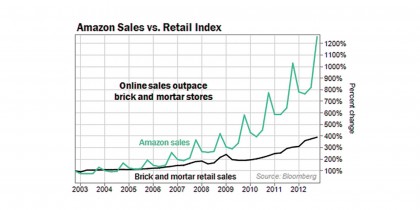E-commerce is transforming the way goods, products, services, and money change hands. But e-commerce isn’t just transferring brick & mortar systems to an online environment. It’s monetizing data.
For years, people have been saying that Amazon is not a commerce company. Amazon is a big data company — it uses data to track demand, logistics to streamline supply chains, and infrastructure to deliver.
 Amazon sales growth increased much more quickly than brick-and-mortar sales growth.
Amazon sales growth increased much more quickly than brick-and-mortar sales growth.
Let’s step back a bit. What was the harbinger of big data? Grocery store loyalty cards. We saw the rise of loyalty cards in the 1990s, when grocery stores across the nation raised the price of a gallon of milk by 50 cents and then gave customers who used a loyalty card a 50-cent discount. You can insert whatever price increase and discount you like. The key is: customers everywhere were paying the same price they had before, but providing the grocery company with their data—what they ate, how often they purchased products. Grocery stores suddenly had access to personalized data for how customers ultimately spent their money.
Grocery stores could use this data to make logistical decisions about how to stock their shelves. But they also used it to target TV ads to customers and individualize the way they sell—in turn, this data makes it possible to individualize the way products are designed.
Think about what Amazon, Google, and Visa know about you. Today’s commerce is driven by knowledge of the customer — that’s what makes e-commerce so efficient, so individualized and tuned to your preferences, and at the end of the day, so powerful.
Read the rest of the article on Medium.

